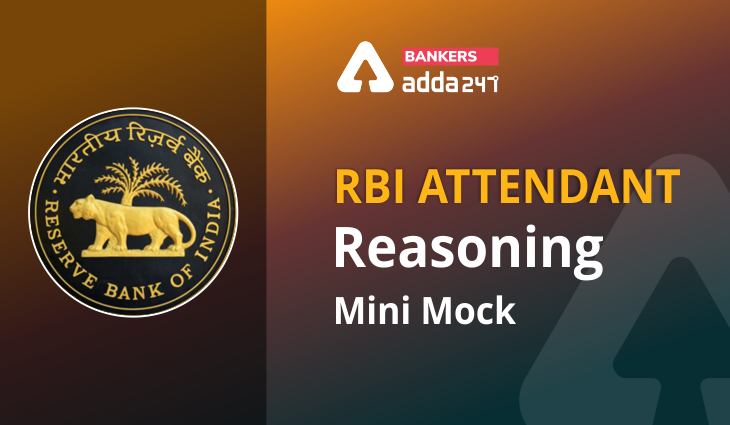Table of Contents
Directions (1-5): These questions are based on the following set of numbers.
417 843 236 758 625
Q1. If in each number first digit is replaced by the second digit, second digit is replaced by the third digit and third digit is replaced by the first digit, then which number will be the second lowest?
(a) 625
(b) 843
(c) 236
(d) 758
(e) 417
Q2. If in each number, the first and the third digits are interchanged, and then which number will be the highest?
(a) 843
(b) 417
(c) 236
(d) 758
(e) 625
Q3. If all the numbers are arranged in descending order, then what will be the difference between the second digit of highest number and third digit of second highest number?
(a) 1
(b) 2
(c) 4
(d) 5
(e) 0
Q4. If ‘1’ is added to all even digits in all the numbers, in which of the following numbers will the difference between the first and second digit be less than two?
(a) 625
(b) 843
(c) 236
(d) 758
(e) 417
Q5. If in each number all the digits are arranged in ascending order within the number, then what will be the difference between lowest and highest number thus formed?
(a) 431
(b) 469
(c) 530
(d) 433
(e) 429
Q6. If in the digits of the number “46752983” one is added to each even digit and one is subtracted from each odd digit, then how many digits will be repeated in the new number formed?
(a) Two
(b) One
(c) Three
(d) Four
(e) None of these
Q7. If the digits of the number “46752983” are arranged in increasing order form left to right within the number, then how many digits will remain on the same position after the applied operation?
(a) Two
(b) One
(c) Three
(d) Four
(e) None of these
Directions (8-10): The following questions are based on the five three-digit numbers given below:
837 321 215 487 726
Q8. If in each number, all the three digits are arranged in ascending order within the number, which of the following will be the 2nd lowest number?
(a) 487
(b)837
(c) 726
(d)321
(e) 215
Q9. If first digit will be interchanged with second digit, which number will be highest?
(a) 487
(b)837
(c) 726
(d)321
(e) 215
Q10. If 1 is subtracted from the first and 1 is added to the third digits of the numbers , then how many numbers thus formed will be completely divisible by 2?
(a) None
(b) Three
(c) More than three
(d) One
(e) Two
Directions (11-15): These questions are based on the following arrangement. Study it carefully and answer the questions below it.
1 3 5 3 4 5 9 2 8 7 2 3 6 5 2 7 3 8 1 2 1 8 4 9 8 1 2 4 7 3 5 2 4 8 9 8 2 4
Q11. Which element is exactly midway between the seventh element from the left end and sixteenth from the right end?
(a) 8
(b) 2
(c) 5
(d) 6
(e) 7
Q12. How many perfect squares are there to the right of the fourteenth element from the right end?
(a) Two
(b) One
(c) Three
(d) Four
(e) more than four
Q13.How many perfect cubes are there in the above arrangement, each of which is immediately preceded by an odd number and immediately followed by an even number?
(a) None
(b) Three
(c) Two
(d) One
(e) More than three
Q14. How many such odd digits are there in the given arrangement, each of which is immediately followed and preceded by an odd number?
(a) None
(b) One
(c) Two
(d) Three
(e) More than three
Q15. Which of the following element is 5th to the right of 10th from the right end?
(a) 9
(b) 8
(c) 2
(d) 1
(e) 4
Practice More Questions of Reasoning for Competitive Exams:
Reasoning for Competitive Exams |
Reasoning Ability Quiz For ECGC PO 2021- 28th February |
Reasoning Ability Quiz For ECGC PO 2021- 27th February |
ECGC PO Study Plan 2021 |
Solutions
S1. Ans.(a)
Sol. New arrangement will be 587 256 174 438 362.
S2. Ans.(d)
S3. Ans.(c)
S4. Ans.(c)
S5. Ans.(a)
S6. Ans(e)
Sol.

S7. Ans(a)
Sol.

S8.Ans(e)
S9.Ans(a)
S10.Ans(c)
S11.Ans(b)
S12.Ans(e)
S13.Ans(c)
S14.Ans(d)
S15.Ans(b)
Practice with Crash Course and Online Test Series for ECGC PO 2021:
- ECGC Online Coaching Classes for Probationary Officier 2021
- ECGC PO Mock Tests 2021 – Banking Online Test Series (With Solutions) by Adda247
- ECGC PO 2021 Complete eBooks Kit (English Medium)
Click Here to Register for Bank Exams 2020 Preparation Material




 GA Capsule for SBI Clerk Mains 2025, Dow...
GA Capsule for SBI Clerk Mains 2025, Dow...
 The Hindu Review October 2022: Download ...
The Hindu Review October 2022: Download ...
 30 Days Study Plan to Crack SBI Clerk 20...
30 Days Study Plan to Crack SBI Clerk 20...





